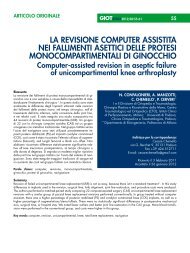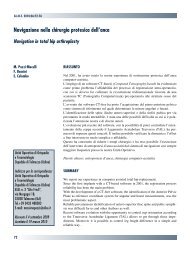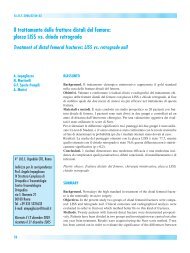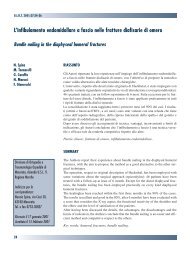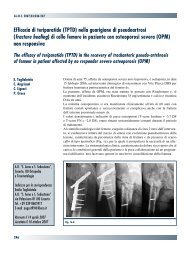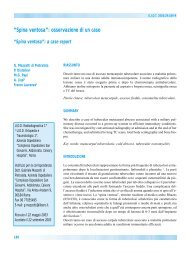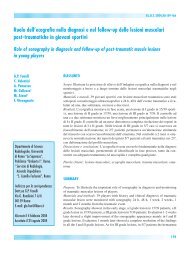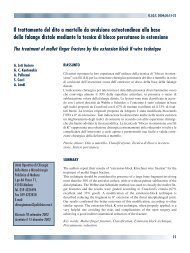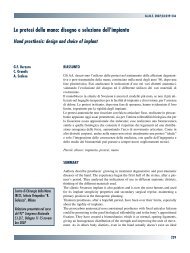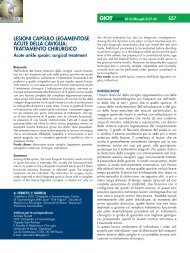Vol.XXXVII, Suppl. 1 - Giornale Italiano di Ortopedia e Traumatologia
Vol.XXXVII, Suppl. 1 - Giornale Italiano di Ortopedia e Traumatologia
Vol.XXXVII, Suppl. 1 - Giornale Italiano di Ortopedia e Traumatologia
You also want an ePaper? Increase the reach of your titles
YUMPU automatically turns print PDFs into web optimized ePapers that Google loves.
LE LEsioni ostEocondraLi<br />
<strong>di</strong> ginocchio E caVigLia:<br />
EspEriEnZE cLinichE con<br />
scaffoLd in acido jaLuronico<br />
osteochondral lesions of knee and ankle:<br />
clinical experiences with hyaluronic acid<br />
scaffold<br />
riassunto<br />
introduzione: Le lesioni osteocondrali (LOC) sono lesioni che<br />
spesso necessitano <strong>di</strong> un trattamento chirurgico. I <strong>di</strong>stretti anatomici<br />
più frequentemente interessati sono il ginocchio e la caviglia.<br />
Le tecniche chirurgiche proposte in letteratura per il loro<br />
trattamento sono numerose, con risultati non univoci.<br />
obiettivi: Scopo <strong>di</strong> questo lavoro è quello <strong>di</strong> descrivere la nostra<br />
esperienza con l’uso <strong>di</strong> uno scaffold in acido ialuronico per la<br />
riparazione delle lesioni cartilaginee <strong>di</strong> ginocchio e caviglia in<br />
ambito rigenerativo cellulare.<br />
Meto<strong>di</strong>: Tra il 2001 e il 2006 46 pazienti affetti da LOC<br />
dell’astragalo sono stati operati con trapianto <strong>di</strong> condrociti autologhi<br />
in artroscopia (TCA), mentre 50 pazienti hanno ricevuto<br />
un trattamento analogo per una LOC a carico del ginocchio.<br />
Nell’ottobre 2005 è stata ideata e sviluppata presso il nostro<br />
centro la meto<strong>di</strong>ca <strong>di</strong> trapianto <strong>di</strong> cellule mononucleate midollari<br />
(TCMM): dall’ottobre 2005 al novembre 2007 sono stati<br />
operati 60 pazienti per LOC della caviglia, e 20 pazienti per<br />
LOC del ginocchio. Tutti i pazienti sono stati sottoposti a valutazione<br />
clinica e RMN preoperatoriamente e a follow-up stabiliti;<br />
in alcuni casi è stata effettuata una artroscopia <strong>di</strong> controllo con<br />
prelievo <strong>di</strong> tessuto rigenerato per esame istologico.<br />
risultati: I pazienti operati con le tecniche descritte hanno riportato<br />
un aumento significativo nello score clinico ai follow-up, con<br />
risultati durevoli nel tempo, specialmente per quanto riguarda il<br />
TCA in cui il follow-up è maggiore. Le RMN eseguite a <strong>di</strong>stanza<br />
<strong>di</strong> 12 e 24 mesi hanno mostrato nel tempo una progressiva<br />
rigenerazione dei tessuti osseo e cartilagineo.<br />
Le 4 artroscopie <strong>di</strong> controllo effettuate a 12 e 24 mesi dall’intervento<br />
hanno mostrato un tessuto cartilagineo rigenerato <strong>di</strong><br />
buona qualità. Le biopsie <strong>di</strong> controllo hanno evidenziato una<br />
buona rigenerazione cartilaginea nei TCA, mentre nei TCMM si<br />
è osservato un rigenerato sia osseo che cartilagineo.<br />
r. Buda, f. Vannini, M. caVaLLo, a. ruffiLLi,<br />
a. parMa, g. pagLiaZZi, L. raMponi, s. giannini<br />
II Clinica Ortope<strong>di</strong>co-Traumatologica,<br />
Istituto Ortope<strong>di</strong>co Rizzoli, Bologna<br />
In<strong>di</strong>rizzo per la corrispondenza:<br />
Marco Cavallo<br />
Clinica Ortope<strong>di</strong>co-Traumatologica II<br />
Via Pupilli 1, 40136 Bologna<br />
Tel. +39 328 1629599<br />
E-mail: cavallo.mrc@libero.it<br />
agosto2011;37(suppl.1):173-180 s173<br />
conclusioni: I risultati clinici, <strong>di</strong> imaging ed istologici hanno<br />
confermato l’efficacia e l’affidabilità delle tecniche chirurgiche<br />
utilizzate sia per il ginocchio che per la caviglia. Il TCA in artroscopia<br />
è ormai giunto ad un follow up <strong>di</strong> me<strong>di</strong>o termine, mentre<br />
il TCMM è ancora ad un follow-up breve, anche se i risultati appaiono<br />
sovrapponibili al TCA, con il vantaggio <strong>di</strong> una riduzione<br />
dei costi e un maggior confort per il paziente.<br />
summary<br />
introduction: Osteochondral lesions (OCL) are lesions that often<br />
requie surgical treatment. Most affected sites are knee and ankle.<br />
Several surgical techniques have been proposed over time,<br />
with <strong>di</strong>fferent outcomes.<br />
objectives: Aim of this work is to describe our experience with<br />
the use of a hyaluronic acid scaffold for OCL repair in knee and<br />
ankle in the field of cell therapies.<br />
Methods. Between 2001 and 2006 46 patients affected by talar<br />
OCL underwent arthroscopic autologous chondrocyte implantation<br />
(ACI), while 50 patients received the same kind of treatment<br />
for knee OCL. In October 2005 at our institution has been developed<br />
the technique of bone marrow derived cells transplantation<br />
(BMDCT): between October 2005 and November 2007 60<br />
patients were operated for talar OCL and 20 for knee OCL. All<br />
the patients were evaluated clinically and with MRI pre-op and<br />
at follow up; I nsome case a control arthroscopy was performed<br />
with bioptic histological examination.<br />
results: All the patients reported a significative clinical improvement<br />
at fu, with durable results expecially for ACI, where FU is<br />
longer. MRI at 12 and 24 months showed a progressive regeneration<br />
of cartilaginous and bony tissue over time. The 4 control<br />
arthroscopies performed at 12 and 24 months showed a good<br />
quality cartilaginous tissue. Biopses showed a good cartilage<br />
regeneration for ACI patients, and both a cartilage and bony<br />
regeneration for BMDCT.<br />
conclusions: Clinical, imaging and histological results confirmed<br />
the feasibility and the efficacy of these procedures for both knee<br />
and ankle. ACI is now at mid term FU, while BMDCT is now at<br />
short time FU, but results are similar to ACI, with the advantages<br />
of lower costs and less patient’s morbi<strong>di</strong>ty.<br />
Key words: osteochondral lesions, hyaluronic acid, autologous<br />
chondrocite implantation, bone marrow mononuclear cells transplantation,<br />
ankle, knee<br />
introduZionE<br />
Le lesioni osteocondrali (LOC) sono lesioni che interessano<br />
sia la cartilagine articolare che l’osso sottocondrale e<br />
che, data la scarsa capacità riparativa della cartilagine<br />
articolare, spesso necessitano <strong>di</strong> un intervento chirurgico.<br />
I <strong>di</strong>stretti anatomici più frequentemente interessati sono il<br />
ginocchio e la caviglia.<br />
In letteratura sono descritte numerose tecniche chirurgiche<br />
volte al trattamento delle LOC; esse comprendono la semplice<br />
bonifica della sede <strong>di</strong> lesione, tecniche <strong>di</strong> stimolazione<br />
midollare (drilling, microfratture), trapianto <strong>di</strong> segmenti<br />
osteocondrali (mosaicoplastica, osteochondral autografts<br />
tranfer system) o tecniche rigenerative (trapianto <strong>di</strong> condro-



